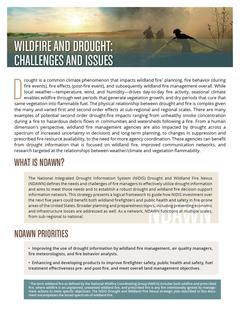Wildfire and Drought: Challenges and Issues
Drought is a common climate phenomenon that impacts wildland fire1 planning, fire behavior (during fire events), fire effects (post-fire event), and subsequently wildland fire management overall. While local weather—temperature, wind, and humidity—drives day-to-day fire activity, seasonal climate enables wildfire through wet periods that generate vegetation growth, and dry periods that cure that same vegetation into flammable fuel. The physical relationship between drought and fire is complex given the many and varied first and second order effects at sub-regional and regional scales. There are many examples of potential second order drought-fire impacts ranging from unhealthy smoke concentration during a fire to hazardous debris flows in communities and watersheds following a fire. From a human dimension’s perspective, wildland fire management agencies are also impacted by drought across a spectrum of increased uncertainty in decisions and long-term planning, to changes in suppression and prescribed fire resource availability, to the need for more agency coordination. These agencies can benefit from drought information that is focused on wildland fire, improved communication networks, and research targeted at the relationships between weather/climate and vegetation flammability.
WHAT IS NDAWN?
The National Integrated Drought Information System (NIDIS) Drought and Wildland Fire Nexus (NDAWN) defines the needs and challenges of fire managers to effectively utilize drought information and aims to meet those needs and to establish a robust drought and wildland fire decision-support information network. This strategy presents a logical framework to guide how NIDIS investment over the next five years could benefit both wildland firefighters and public health and safety in fire-prone areas of the United States. Broader planning and preparedness topics, including preventing economic and infrastructure losses are addressed as well. As a network, NDAWN functions at multiple scales, from sub-regional to national.
NDAWN PRIORITIES
• Improving the use of drought information by wildland fire management, air quality managers, fire meteorologists, and fire behavior analysts.
• Enhancing and developing products to improve firefighter safety, public health and safety, fuel treatment effectiveness pre- and post-fire, and meet overall land management objectives.
KEY COLLABORATIONS/PARTNERS
There are established groups working with aspects of drought research and communication, and those who are primarily consumers of drought information. A goal of NDAWN is to better connect these entities to expand and improve formal collaborations and partnerships. Connection with each of these groups to varying extent has already been made but furthering these connections and adding new ones will build the NDAWN capacity.
The list of potential new collaborators/ partners includes:
NIFC Predictive Services
Prescribed Fire Councils/Alliances
Fire Management Agencies
Cohesive Strategy Regional Committees (Northeast, Southeast, West)
National Weather Service
NOAA Regional Integrated Sciences and Assessments Teams
DOI Climate Adaptation Science Centers
USDA Climate Hubs
State fire management agencies
Private sector entities
NDAWN STRATEGIC PLAN
In 2018, NDAWN developed a strategic plan, that provides guidance on recommended activities in knowledge transfer, tool development, science research, and communication. Desired outputs and outcomes across the next five years and beyond are also detailed in the report. The logic on the backside provides a snapshot of the strategic plan.
For more information, please contact:
Britt Parker, NIDIS Coordinator
1 The term wildland fire as defined by the National Wildfire Coordinating Group (NWCG) includes both wildfire and prescribed fire, where wildfire is an unplanned, unwanted wildland fire, and prescribed fire is any fire intentionally ignited by management actions to meet specific objectives. The NIDIS Drought and Wildland Fire Nexus strategic plan described in this document encompasses the broad spectrum of wildland fire.


